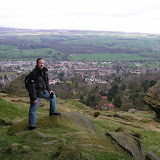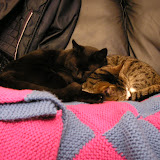Friday, August 17, 2007
Thursday, August 16, 2007
Tuesday, August 07, 2007
Monday, June 04, 2007
Student Evaluation Forms
Most of the evaluations were very positive and the students seemed to really enjoy the course. That makes me very happy and although I probably won't feel the same way in September, I am looking forward to teaching the course again. In the past I've had these grand ideas for how to approach the subject and make it interesting for the students, but sadly I feel that I don't implement a third of the ideas. What usually ends up happening is that I get so busy with my thesis or something else that I just review the material the night before the seminar, doing the minimal amount of preparation required. And I feel guilty about that because I know I can do more. I need to re-read these evaluation forms just before next term so that it will inspire me to put more effort into tutoring.
Monday, May 21, 2007
Durham
The weather was wonderful. We walked from the station up to the cathedral and lunched at the restaurant across from the treasury. We got there early in order to have time to look around the cathedral itself before going to see the sculptures.
Durham is one of the most beautiful cathedrals in England. It was built with this wonderful orange sandstone. Construction on the present cathedral began in 1093 and it was finished after 40 years and most of the original structure is still intact. The main part of the cathedral is an excellent example of Romanesque architecture, and later additions, the Gallilee Chapel and Chapel of the Nine Altars, are built in the gothic style.
The cathedral is significant not only for its architectural beauty, but also because it is where the bones of St Cuthbert and the Venerable Bede now rest. Cuthbert was originally buried at Lindisfarne and Bede at Jarrow, but during period of Viking attacks, their bones were moved and eventually both ended up at Durham. You can see Cuthbert's wooden coffin (made in 697 when he was dug up 11 years after his death and found to be incorrupt) in the treasury. It's amazing to see an intact wooden coffin from the seventh century. Pictures of the apostles and archangels decorate the coffin. Bede rests in the Gallilee chapel. I still get goosebumps every time I go to his tomb. His work is such a pivotal part of my research. Because of Bede we know so much about the early history of England. Yet, part of my thesis is critique of Bede and reconstructing what he is deliberately not telling us. In my mind I picture him as resembling Ian Holm.
The tour of the Monk's Dormitory was great. Instead of housing monks, it is now used as a library, the type I'd like to spend my time lounging in. The stone sculpture was fantastic. Catherine Karkov, one of the foremost experts on Anglo-Saxon stone sculpture, gave a talk about the artefacts we saw in the Monk's Dormitory.
So, I took pictures. Unfortunately photographs were not allowed inside the cathedral, but I did take pictures inside the Monk's Dormitory and around Durham. Go see for yourself:
Friday, May 04, 2007
Wednesday, May 02, 2007
Wednesday, April 11, 2007
Ilkley Moor - Don't forget your hat!
 |
| Ilkley |
Friday, March 30, 2007
Thursday, March 29, 2007
Tuesday, March 20, 2007
Of course, African swallows are non-migratory
Monday, March 19, 2007
Ambrose & Kira
 |
| Cats |
Saturday, March 17, 2007
The History of the World according to Undergraduates
Last term I taught a history course that was a general survey of European History from the end of the Roman Empire to the present day. I didn't give lectures, I just lead seminars, which is where the students are broken into smaller groups and they talk about certain topics in depth. I marked their essays and graded their exams. Some of these made me proud, as they demonstrated that the students were paying attention and getting something out of the course. Most of them were mediocre, and a few made me cringe. For their final exams, I wrote down the cringe-worthy ones and share them with you now. Here is the history of the world, according to undergraduates.
Many barbarian tribes joined the Roman Empire due to the benefits they could
receive...King Theodoric received a Roman spin doctor for his cooperation.
Wherever Latin Christendom expanded to, it brought with it Christianity.
The early Roman emperors were considered to be gods on earth.
One of the earliest known multi-nation empires was the first Persian Empire,
which began in the sixth century BC. This empire even included many areas
within Britain.Modernity must be seen as the final stage in the process of Modernisation, the
stage reached after the varying processes of modernisation have completed and
begun to work together. Modernity is a time, not a definition.What makes such an essay [defining the characteristics of modernity] hard to
right [sic] is the fact that we are in the process of leaving or are still in
the modern era.The crusades were steeped with a notion of expanding Christendom into its
spiritual heartland and in turn encompassing the East under a new 'Roman' sense
of identity.The year 1500 is often seen as a transition to modernity, displaying
characteristics such as improved economic administration and social structure.The adoption of Christianity would also lead to the Reformation dividing
Catholics and Protestants.
The following four statements are from the same exam.
As Voltaire argued, the Roman Empire was not "Holy, nor Roman, nor an
Empire".
Ferdinand and Isabella sent Columbus as a missionary but his hunt for gold and
wealth in the New World turned the native people into an inferior
race.
The Renaissance beginning around 1200 became the start of a move away
from religion, papacy, and absolute rule.
The British Empire and its success have changed the course of history to the
extent that it may be the reason I am sitting here today.
Monday, March 05, 2007
Friday, March 02, 2007
House Hunting
Birmingham Museum & Art Gallery
Wednesday, February 28, 2007
Snowed Under
On top of that, it appears that Kat and I might have to start looking for a new place to live in, as we have just been informed that our landlord intends to sell the house where we currently reside. I don't want to look for a new place. I like where we live and I don't want to have to move again.
Despite all this I have agreed to be interviewed on camera for a project by some broadcast journalism students. They're doing something on paganism, and I agreed to talk about the history of paganism. We'll be filming at Kirkstall Abbey. Hopefully we'll be done in time for me to attend the IMS lecture this evening at 5:30pm, Sea-faring Saints and Land-lubber Painters. After the lecture, the Medieval Film Society is screening Erik the Viking. There's been a lot of other things going on, some good some bad. I'll only mention the good. I have applied for a summer course in Budapest on Late Antiquity. I haven't learned whether or not I've been accepted, but I think I've got a good shot at it. Also, Kat and I went to Birmingham yesterday to meet up with an old friend from New Orleans, who is in the country with her boyfriend. We had a good visit with them at the Birmingham Museum & Art Gallery, which has one of the largest collections of pre-Raphaelite drawings in the world. I'll make another post and include pictures in the near future. I must go and eat lunch now.
